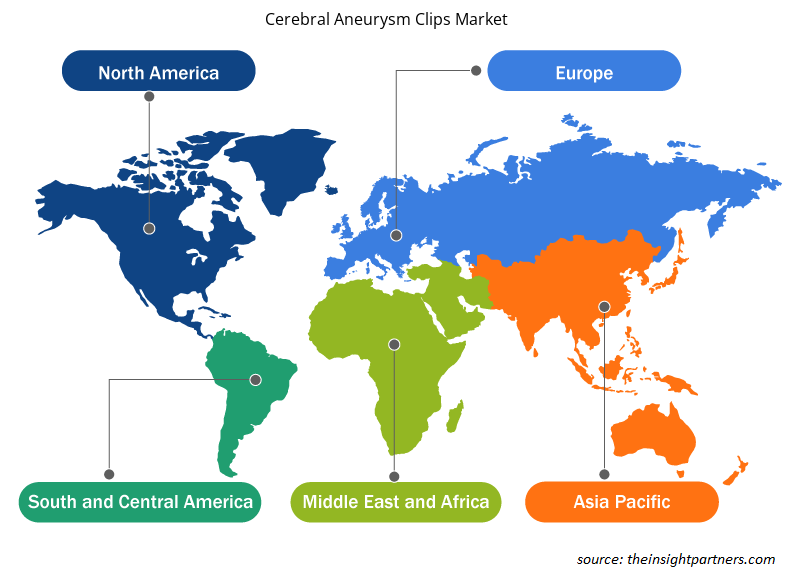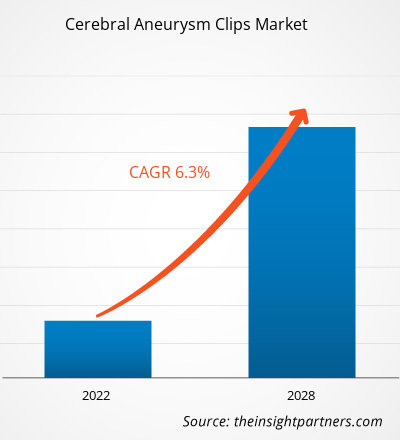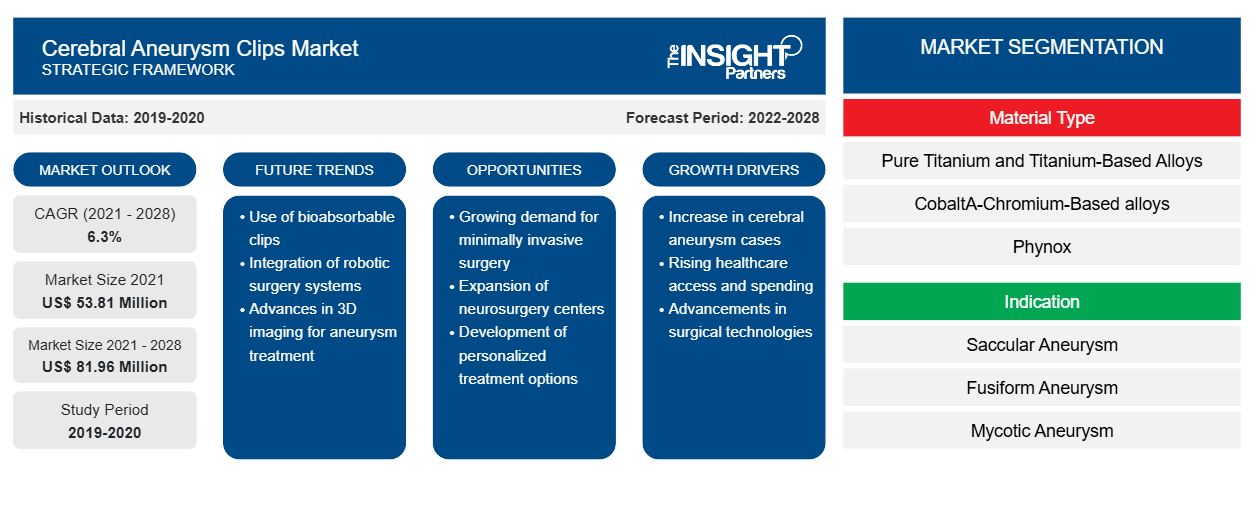Se espera que el mercado de clips para aneurismas cerebrales crezca de US$ 53.810,74 mil en 2021 a US$ 81.960,74 mil en 2028. Se estima que crecerá a una CAGR del 6,3% entre 2022 y 2028.
Un aneurisma cerebral es la formación de una protuberancia en los vasos sanguíneos del cerebro. La protuberancia ejerce presión sobre los nervios o los tejidos cerebrales y su ruptura puede provocar una hemorragia cerebral, que puede ser mortal para el paciente. Factores como las enfermedades genéticas, las malformaciones arteriovenosas, la hipertensión no tratada y el tabaquismo provocan aneurismas cerebrales. El clip microquirúrgico es el método más establecido para tratar los aneurismas. El primer aneurisma tratado mediante clipaje quirúrgico se realizó en el Hospital Johns Hopkins el 23 de marzo de 1937. Durante el clipaje microquirúrgico, se utiliza un pequeño clip metálico para detener el flujo sanguíneo hacia el aneurisma. Se realiza una craneotomía para crear una abertura en el cráneo para llegar al aneurisma. El clip se coloca en el cuello (abertura) del aneurisma para obstruir el flujo sanguíneo y se deja dentro del cerebro después de los procedimientos.
El informe ofrece información y un análisis profundo del mercado global de clips para aneurismas cerebrales , haciendo hincapié en varios parámetros que incluyen tendencias del mercado, avances tecnológicos, dinámica del mercado y análisis del panorama competitivo de los principales actores del mercado global. También incluye el impacto de la pandemia de COVID-19 en el mercado en todas las regiones principales. El mercado de clips para aneurismas cerebrales experimentó el impacto general mixto de la pandemia de COVID-19 y, por lo tanto, el mercado sigue ganando terreno y se espera que crezca en los próximos años. Durante esta emergencia sanitaria, brindar atención médica a todos los pacientes se convirtió en un desafío para los sistemas de atención médica, que se vieron sobrecargados debido a la necesidad de tratar a la gran cantidad de pacientes con COVID. Las empresas de dispositivos médicos también enfrentaron problemas en la gestión de sus operaciones en 2020. Sin embargo, con la relajación gradual de las restricciones sociales y la reanudación de los procedimientos electivos por parte de los hospitales, la demanda de procedimientos quirúrgicos y accesorios relacionados ha vuelto a niveles normales.
Mercado de clips para aneurismas cerebrales -
Personalice este informe según sus necesidades
Obtendrá personalización en cualquier informe, sin cargo, incluidas partes de este informe o análisis a nivel de país, paquete de datos de Excel, así como también grandes ofertas y descuentos para empresas emergentes y universidades.
- Obtenga las principales tendencias clave del mercado de este informe.Esta muestra GRATUITA incluirá análisis de datos, desde tendencias del mercado hasta estimaciones y pronósticos.
Perspectivas basadas en la geografía
Por geografía, el mercado de clips para aneurismas cerebrales está segmentado en América del Norte (EE. UU., Canadá y México), Europa (Francia, Alemania, Reino Unido, España, Rusia, Italia y resto de Europa), Asia Pacífico (China, India, Japón, Australia, Corea del Sur, Kazajstán y resto de Asia Pacífico), Medio Oriente y África (Arabia Saudita, Emiratos Árabes Unidos, Sudáfrica y resto de Medio Oriente y África) y América del Sur y Central (Brasil, Argentina y resto de América del Sur y Central).UAE, South Africa, and Rest of Middle East & Africa), and South & Central America (Brazil, Argentina, and Rest of South & Central America).
Perspectivas del mercado
El aumento de la población geriátrica impulsa el crecimiento del mercado de clips para aneurismas cerebrales
Los aneurismas cerebrales son comunes entre las poblaciones de edad avanzada, lo que hace más evidente la necesidad de imágenes vasculares no invasivas. Las inconsistencias en la esperanza de vida, la disfunción cognitiva, la vasculopatía, las comorbilidades y los riesgos de ruptura asociados con los tratamientos endovasculares y quirúrgicos heterogéneos contribuyen a un aumento en el uso de clips para aneurismas cerebrales. Según un estudio de investigación realizado en la Facultad de Medicina de la Universidad de Maryland en 2021, la proporción de personas de 65 años o más alcanzará el 21% en 2050 desde el 8,1%. Varios estudios de autopsias han correlacionado la mayor prevalencia de aneurismas cerebrales no rotos con el avance de la edad. Inagawa et al. del Hospital Central de la Prefectura de Shimane, Izumo, Japón, examinaron 10.259 autopsias realizadas en Nueva York. Encontraron que la incidencia de aneurismas cerebrales no rotos era más alta en pacientes de 60 años o más, con una prevalencia máxima del 1,2% en personas de 70 años o más. Iwamoto et al., de la Universidad de Kyushu, Fukuoka, Japón, evaluaron 1230 autopsias en Japón y notificaron un aumento general de la prevalencia de aneurismas no rotos con el avance de la edad en las mujeres, con una prevalencia máxima del 14,5 % en mujeres japonesas de 60 a 69 años. Al revisar los estudios de angiografía por resonancia magnética en 8696 adultos japoneses asintomáticos, Harada et al. identificaron aneurismas cerebrales no rotos en el 3,2 % de los casos, y la prevalencia aumentó con la edad tanto en hombres como en mujeres.vasculopathy, comorbidities, and rupture risks associated with heterogenous endovascular and surgical treatments contribute to a surge in the use of cerebral aneurysm clips. As per a research study conducted at the University of Maryland School of Medicine in 2021, the proportion of individuals aged 65 or above will reach 21% by 2050 from 8.1%. Several autopsy studies have correlated the increased prevalence of unruptured cerebral aneurysms with advancing age. Inagawa et al. from Shimane Prefectural Central Hospital, Izumo, Japan, examined 10,259 autopsies performed in New York. They found the incidence of unruptured cerebral aneurysms highest in patients aged 60 and above, with a peak prevalence of 1.2% in people aged 70 and above. Iwamoto et al., Kyushu University, Fukuoka, Japan, assessed 1,230 autopsies in Japan, reporting an overall increased prevalence of unruptured aneurysms with advancing age in women, with a peak prevalence of 14.5% in Japanese women of age 60–69 years. When reviewing magnetic resonance angiography studies in 8,696 asymptomatic Japanese adults, Harada et al. identified unruptured cerebral aneurysms in 3.2% of cases, and the prevalence increased with age in both men and women.
Muchos estudios potenciales han evaluado la ocurrencia de la ruptura de un aneurisma y su conexión con la vejez. El riesgo general de ruptura por paciente-año en la población general es de 0,6 a 1,3%. Otros factores de riesgo pertinentes incluyen antecedentes de hemorragia subaracnoidea (HSA), hipertensión, tabaquismo, aneurismas múltiples y morfología irregular en la población geriátrica. Algunos estudios afirman que el tamaño del aneurisma puede estar relacionado con la edad del paciente. El Estudio de Aneurismas Cerebrales No Rotos de Japón (UCAS Japón) evaluó 6.697 aneurismas cerebrales; el 39,7% de los pacientes de 80 años o más tenían un tamaño de 7 mm, o se encontraron aneurismas más grandes en el 21,4% de los pacientes de 50 a 59 años. Por lo tanto, el manejo ideal de los aneurismas cerebrales en pacientes de edad avanzada ofrece margen para futuros desarrollos y cuidados avanzados. En la actualidad, el tratamiento es individualizado y requiere un conocimiento preciso de la historia natural y del riesgo de rotura, que deben sopesarse frente a las comorbilidades de cada individuo, la esperanza de vida, los riesgos relacionados con el tratamiento y las posibilidades de éxito. Por ello, con el aumento de la población anciana, con una mayor prevalencia de aneurismas, es probable que las empresas del mercado de aneurismas cerebrales aprovechen importantes oportunidades de crecimiento en los próximos años.subarachnoid hemorrhage (SAH), hypertension, smoking, multiple aneurysms, and irregular morphology in the geriatric population. Some studies state that aneurysm size may be related to patient age. The Unruptured Cerebral Aneurysm Study of Japan (UCAS Japan) evaluated 6,697 cerebral aneurysms; 39.7% of patients aged 80 years and above had a size of 7 mm, or larger aneurysms were found in 21.4% of patients of age 50–59 years. Therefore, the ideal management of cerebral aneurysms in elderly patients provides scope for further developments and advanced care. Management is currently individualized, requiring the precise knowledge of natural history and risk of rupture that must be weighed against an individual's comorbidities, life expectancy, treatment-related risks, and success possibilities. Thus, with the growing elderly population, having a greater prevalence of aneurysms, companies in the cerebral aneurysms market are likely to grab significant growth opportunities in the coming years.
Información basada en el tipo de material
Según el tipo de material, el mercado de clips para aneurismas cerebrales se segmenta en titanio puro y aleaciones a base de titanio, aleaciones a base de cobalto y cromo, phynox y otros. En 2021, se prevé que el segmento de titanio puro y aleaciones a base de titanio tenga la mayor participación de mercado; sin embargo, se prevé que el segmento de phynox registre la CAGR más alta del mercado entre 2022 y 2028.
Perspectivas regionales del mercado de clips para aneurismas cerebrales
Los analistas de Insight Partners explicaron en detalle las tendencias y los factores regionales que influyen en el mercado de clips para aneurismas cerebrales durante el período de pronóstico. Esta sección también analiza los segmentos y la geografía del mercado de clips para aneurismas cerebrales en América del Norte, Europa, Asia Pacífico, Oriente Medio y África, y América del Sur y Central.

- Obtenga datos regionales específicos para el mercado de clips para aneurismas cerebrales
Alcance del informe sobre el mercado de clips para aneurismas cerebrales
| Atributo del informe | Detalles |
|---|---|
| Tamaño del mercado en 2021 | US$ 53,81 millones |
| Tamaño del mercado en 2028 | US$ 81,96 millones |
| CAGR global (2021-2028) | 6,3% |
| Datos históricos | 2019-2020 |
| Período de pronóstico | 2022-2028 |
| Segmentos cubiertos | Por tipo de material
|
| Regiones y países cubiertos | América del norte
|
| Líderes del mercado y perfiles de empresas clave |
|
Densidad de actores del mercado de clips para aneurismas cerebrales: comprensión de su impacto en la dinámica empresarial
El mercado de clips para aneurismas cerebrales está creciendo rápidamente, impulsado por la creciente demanda de los usuarios finales debido a factores como la evolución de las preferencias de los consumidores, los avances tecnológicos y una mayor conciencia de los beneficios del producto. A medida que aumenta la demanda, las empresas amplían sus ofertas, innovan para satisfacer las necesidades de los consumidores y aprovechan las tendencias emergentes, lo que impulsa aún más el crecimiento del mercado.
La densidad de actores del mercado se refiere a la distribución de las empresas o firmas que operan dentro de un mercado o industria en particular. Indica cuántos competidores (actores del mercado) están presentes en un espacio de mercado determinado en relación con su tamaño o valor total de mercado.
Las principales empresas que operan en el mercado de clips para aneurismas cerebrales son:
- B. BRAUN MELSUNGEN AG
- INSTRUMENTOS REBSTOCK GMBH
- GRUPO KLS MARTIN
- CORPORACIÓN DE CIENCIAS DE LA VIDA INTEGRA
- ORTO-MEDICAL GMBH
Descargo de responsabilidad : Las empresas enumeradas anteriormente no están clasificadas en ningún orden particular.

- Obtenga una descripción general de los principales actores clave del mercado de clips para aneurismas cerebrales
Perspectivas basadas en indicaciones
Según las indicaciones, el mercado de clips para aneurismas cerebrales se segmenta en aneurisma sacular, aneurisma fusiforme y aneurisma micótico. El segmento de aneurisma sacular tuvo la mayor participación de mercado en 2021; sin embargo, se prevé que el segmento de aneurisma micótico registre la CAGR más alta del mercado entre 2022 y 2028.
Información basada en el usuario final
Según el usuario final, el mercado de clips para aneurismas cerebrales se segmenta en hospitales, centros de neurología, centros de cirugía ambulatoria y otros. El segmento de hospitales tuvo la mayor participación de mercado en 2021; sin embargo, se estima que el segmento de centros de neurología registrará la CAGR más alta del mercado entre 2022 y 2028.
Los actores del mercado de clips para aneurismas cerebrales adoptan estrategias orgánicas, que incluyen el lanzamiento y la expansión de productos, para expandir su presencia y su cartera de productos en todo el mundo. Los actores clave en el mercado son B. Braun Melsungen AG; Peter Lazic GmbH; Mizuho Medical Co. Ltd; Rebstock Instruments GmbH; KLS Martin Group; Integra Lifesciences Corporation; Ortho-Medical GmbH; y Adeor Medical AG.
- Análisis histórico (2 años), año base, pronóstico (7 años) con CAGR
- Análisis PEST y FODA
- Tamaño del mercado, valor/volumen: global, regional y nacional
- Industria y panorama competitivo
- Conjunto de datos de Excel
Informes recientes
Testimonios
Razón para comprar
- Toma de decisiones informada
- Comprensión de la dinámica del mercado
- Análisis competitivo
- Información sobre clientes
- Pronósticos del mercado
- Mitigación de riesgos
- Planificación estratégica
- Justificación de la inversión
- Identificación de mercados emergentes
- Mejora de las estrategias de marketing
- Impulso de la eficiencia operativa
- Alineación con las tendencias regulatorias





















 Obtenga una muestra gratuita para - Mercado de clips para aneurismas cerebrales
Obtenga una muestra gratuita para - Mercado de clips para aneurismas cerebrales